Active Strike-Slip Faulting and Systematic Deflection of Drainage Systems along the Altyn Tagh Fault, Northern Tibetan Plateau
Abstract
:1. Introduction
2. Tectonic Setting
3. Method and Results
3.1. Theoretical Principle of Systematic Deflection of Stream Channels
3.2. Interpretation and Measurement of Deflected Stream Channels
3.3. Measurement and Results
4. Three Types of Stream Channels
5. Discussion
5.1. Accurate Measurement of the Offset Amount
5.2. Headward Erosion Rate along the Altyn Tagh Fault
5.3. Implications for the Tectonic Deformation of the Tibetan Plateau
6. Conclusions
- (1)
- The stream channels have been systematically deflected and/or offset in a sinistral sense along the active Altyn Tagh Fault in the northern Tibetan Plateau.
- (2)
- A positively related linear relationship between the upstream length L and the offset amount D was obtained along the Altyn Tagh Fault, indicating that the larger rivers generally accumulate larger offset. The channel with bedrock upstream generally has a better correlation between L and D than that of non-bedrock upstream.
- (3)
- The maximum observed cumulative offset recorded by rivers on the Altyn Tagh fault is ~72 km, nevertheless, the real total maximum displacement might be larger than 72 km due to possible river capture and abandonment. Along with these cumulative displacements recorded by other regional-scale strike-slip faults, a limited extrusion to the east is suggested to decipher the deformation of the Tibetan Plateau after the India-Asia collision.
- (4)
- This study provides an example of studying the relationship between development of drainage systems and long-term strike-slip faulting. As a reliable geomorphic feature, the systematic deflection of stream channels is a good carrier to understand the deformational behaviors of strike-slip faulting.
Supplementary Materials
Author Contributions
Funding
Acknowledgments
Conflicts of Interest
References
- Burbank, D.W.; Anderson, R.S. Tectonic Geomorphology, 2nd ed.; Blackwell Publishing Ltd.: Oxford, UK, 2011; pp. 1–5. [Google Scholar]
- Jackson, J.; Norris, R.; Youngsun, J. The structural evolution of active fault and fold systems in central Otago, New Zealand: Evidence revealed by drainage patterns. J. Struct. Geol. 1996, 18, 217–234. [Google Scholar] [CrossRef]
- Walker, R.T. A remote sensing study of active folding and faulting in southern Kerman province, SE Iran. J. Struct. Geol. 2005, 28, 654–668. [Google Scholar] [CrossRef]
- Yan, B.; Lin, A. Systematic deflection and offset of the Yangtze River drainage system along the strike-slip Ganzi-Yushu-Xianshuihe Fault Zone. Tibet. Plateau. J. Geodyn. 2015, 87, 13–25. [Google Scholar] [CrossRef]
- Strahler, A.N. Quantitative analysis of watershed geomorphology. Am. Geophys. Union Trans. 1957, 38, 913–920. [Google Scholar] [CrossRef] [Green Version]
- Brookfield, M.E. The evolution of the great river systems of the southern Asia during the Cenozoic India-Asia collision: Rivers draining southwards. Geomorphology 1998, 22, 285–312. [Google Scholar] [CrossRef]
- Kirby, E.; Whipple, K. Quantifying differential rock-uplift rates via stream profile analysis. Geology 2001, 29, 415–418. [Google Scholar] [CrossRef]
- Chen, P.; Lin, A. Topographic divides formed by active flexural folding in the NE marginal zone of the Tibetan Plateau. Geomorphology 2019, 332, 1–9. [Google Scholar] [CrossRef]
- Wallace, R.E. The San Andreas fault in the Carrizo Plain-Temblor Range region, California. San Andreas fault in southern California: A guide to San Andreas fault from Mexico to Carrizo Plain. Calif. Div. Mines Geol. Spec. Rep. 1975, 118, 241–250. [Google Scholar]
- Huang, W. Morphologic patterns of stream channels on active Yishi Fault, southern Shandong Province, Eastern China: Implications for repeated great earthquakes in the Holocene. Tectonophysics 1993, 219, 283–304. [Google Scholar] [CrossRef]
- Matsuda, T. Active fault assessment for Irozaki fault system, Izu Peninsula. In Reports on the Earthquake off the Izu Peninsula, 1974, and the Disaster; Tsuchi, R., Ed.; Kurofune Press: Shizuoka, Japan, 1975; pp. 121–125. (In Japanese) [Google Scholar]
- Noriega, G.R.; Arrowsmith, J.R.; Grant, L.B.; Young, J.J. Stream channel offset and Late Holocene slip rate of the San Andreas Fault at the Van Matre Ranch Site, Carrizo Plain, California. Bull. Seismol. Soc. Am. 2006, 96, 33–47. [Google Scholar] [CrossRef]
- Maruyama, T.; Lin, A. Tectonic history of the Rokko active fault zone (southwest Japan) as inferred from cumulative offsets of stream channels and basement rocks. Tectonophysics 2000, 323, 197–216. [Google Scholar] [CrossRef]
- Klinger, Y.; Etchebes, M.; Tapponnier, P.; Narteau, C. Characteristic slip for five great earthquakes along the Fuyun fault in China. Nat. Geosci. 2011, 4, 389–392. [Google Scholar] [CrossRef]
- Ren, Z.K.; Zhang, Z.Q.; Chen, T.; Yan, S.L.; Yin, J.H.; Zhang, P.Z.; Zheng, W.J.; Zhang, H.P.; Li, C.Y. Clustering of offsets on the Haiyuan Fault and their relationship to paleo-earthquakes. Geol. Soc. Am. Bull. 2016, 128, 3–18. [Google Scholar] [CrossRef]
- Kang, W.; Xu, X.; Oskin, M.E.; Yu, G.; Luo, J.; Chen, G.; Luo, H.; Sun, X.; Wu, X. Characteristic slip distribution and earthquake recurrence along the eastern Altyn Tagh fault revealed by high-resolution topographic data. Geosphere 2019, 16, 392–406. [Google Scholar] [CrossRef] [Green Version]
- Gaudemer, Y.; Tapponnier, P.; Turcotte, D.L. River offsets across active strike-slip faults. Ann. Tecton. 1989, 3, 55–76. [Google Scholar]
- Tapponnier, P.; Peltzer, G.; Ledain, A.Y.; Cobbold, P. Propagating extrusion tectonics in Asia–New insights from simple experiments with plasticine. Geology 1982, 10, 611–616. [Google Scholar] [CrossRef]
- Tapponnier, P.; Xu, Z.Q.; Roger, F.; Meyer, B.; Amaud, N.; Wittlinger, G.; Yang, J.S. Oblique stepwise rise and growth of the Tibet Plateau. Science 2001, 294, 1671–1677. [Google Scholar] [CrossRef]
- Wittlinger, G.; Tapponnier, P.; Ooupinet, G.; Jiang, M.; Shi, D.; Herquel, G.; Masson, F. Tomographic evidence for localized lithospheric shear along the Altyn Tagh fault. Science 1998, 282, 74–76. [Google Scholar] [CrossRef] [PubMed] [Green Version]
- Peltzer, G.; Tapponnier, P. Formation and evolution of strike-slip faults, rifts, and basins during the India-Asia collision: An experimental approach. J. Geophys. Res. 1988, 93, 15085–15117. [Google Scholar] [CrossRef]
- Cowgill, E.; Yin, A.; Harrison, T.M.; Feng, W.X. Reconstruction of the Altyn Tagh fault based on U–Pb geochronology: Role of backthrusts, mantle sutures and heterogeneous crustal strength in the forming the Tibetan plateau. J. Geophys. Res. 2003, 108. [Google Scholar] [CrossRef]
- Yin, A.; Rumelhrt, P.E.; Bulter, R.; Cowgill, E.; Harrison, T.M.; Foster, D.A.; Foster, D.A.; Ingersoll, R.V.; Zhang, Q.; Zhou, X.Q.; et al. Tectonic history of the Altyn Tagh fault system in northern Tibet inferred from Cenozoic sedimentation. GSA Bull. 2002, 114, 1257–1295. [Google Scholar] [CrossRef]
- Chen, Y.; Gilder, S.; Halim, N.; Cogne, J.P.; Courtillot, V. New paleomagnetic constraints on central Asian kinematics: Displacement along the Altyn Tagh fault and rotation of the Qaidam Basin. Tectonics 2002, 21, 1–19. [Google Scholar] [CrossRef] [Green Version]
- Ding, G.Y.; Chen, J.; Tian, Q.J.; Shen, X.H.; Xing, C.Q.; Wei, K.B. Active faults and magnitudes of left-lateral displacement along the northern margin of the Tibetan Plateau. Tectonophysics 2004, 380, 243–260. [Google Scholar] [CrossRef]
- Zhang, Y.Q.; Chen, Z.L.; Yang, N. New geological evidence for late Cenozoic left-lateral displacement along the Altyn Tagh Fault. Geoscience 2001, 15, 8–12, (In Chinese with English Abstract). [Google Scholar]
- Yin, A. Cenozoic tectonic evolution of the Himalayan orogen as constrained by along-strike variation of structural geometry, exhumation history, and foreland sedimentation. Earth Sci. Rev. 2006, 76, 1–131. [Google Scholar] [CrossRef]
- Cowgill, E.; Gold, R.D.; Chen, X.; Wang, X.; Arrowsmith, J.R.; Southon, J. Low Quaternary slip rate reconciles geodetic and geologic rates along the Altyn Tagh fault, northwestern Tibet. Geology 2009, 37, 647–650. [Google Scholar] [CrossRef]
- Zhang, P.Z.; Molnar, P.; Xu, X.W. Late Quaternary and present-day rates of slip along the Altyn Tagh Fault, northern margin of the Tibetan Plateau. Tectonics 2007, 26. [Google Scholar] [CrossRef] [Green Version]
- Yin, A.; Harrison, T.M. Geologic evolution of the Himalayan-Tibetan orogeny. Annu. Rev. Earth Planet. Sci. 2000, 28, 211–280. [Google Scholar] [CrossRef] [Green Version]
- Yue, Y.; Ritts, B.D.; Graham, S.A. Initiation and long-term slip history of the Altyn Tagh fault. Int. Geol. Rev. 2001, 43, 1087–1093. [Google Scholar] [CrossRef]
- Yue, Y.; Ritts, B.D.; Hanson, A.D.; Graham, S.A. Sedimentary evidence against large strike-slip translation on the northern Altyn Tagh fault, NW China. Earth Planet. Sci. Lett. 2004, 228, 311–323. [Google Scholar] [CrossRef]
- Chen, Z.L.; Zhang, Y.Q.; Chen, X.H.; Wang, X.F.; Washburn, Z.; Arrowsmith, J. Late Cenozoic sedimentary process and its Response to the slip history of central Altyn Tagh Fault, northern Qinghai-Tibetan plateau. Sci. China (D) 2001, 44, 103–111. [Google Scholar] [CrossRef]
- Yue, Y.; Ritts, B.D.; Graham, S.A.; Wooden, J.L.; Gehrels, G.E.; Zhang, Z. Slowing extrusion tectonics: Lowered estimate of post-Early Miocene slip rate for the Altyn Tagh fault. Earth Planet. Sci. Lett. 2003, 217, 111–122. [Google Scholar] [CrossRef]
- Peltzer, G.; Tapponnier, P.; Armijo, R. Magnitude of late Quateranry left-lateral displacements along the north edge of Tibet. Science 1989, 246, 1285–1289. [Google Scholar] [CrossRef] [PubMed]
- Xu, X.W.; Tapponnier, P.; Van Der Woerd, J.; Ryerson, F.J.; Wang, F.; Zheng, R.Z.; Chen, W.B.; Ma, W.T.; Yu, G.H.; Chen, G.H.; et al. Late Quaternary left-lateral strike-slip rate of the Altyn Tagh Fault zone and its transferring model of tectonic movement. Sci. China (Ser. D) 2003, 33, 967–974. [Google Scholar]
- Mériaux, A.S.; Ryerson, F.J.; Tapponnier, P.; Van der Woerd, J.; Finkel, R.C.; Xu, X.W.; Xu, Z.Q.; Caffee, M.W. Rapid slip along the central Altyn Tagh Fault: Morphochronologic evidence from Cherchen He and Sulamu Tagh. J. Geophys. Res. 2004, 109, B06401. [Google Scholar] [CrossRef]
- Wang, F.; Xu, X.; Zheng, R. Slip-rate on the eastern Altyn Tagh fault since 20 ka BP. Seismol. Geol. 2003, 24, 349–358, (In Chinese with English Abstract). [Google Scholar]
- Wang, F.; Xu, X.; Zheng, R. Study on Holocene strike-slip rates of the middle Altyn Tagh fault by terraces offset measurement. Seismol. Geol. 2004, 26, 61–70, (In Chinese with English Abstract). [Google Scholar]
- Gold, R.D.; Cowgill, E.; Arrowsmith, J.R.; Gosse, J.; Chen, X.; Wang, X. Riser diachroneity, lateral erosion, and uncertainty in rates of strike-slip faulting: A case study from Tuzidun along the Altyn Tagh Fault, NW China. J. Geophys. Res. 2009, 114, B04401. [Google Scholar] [CrossRef] [Green Version]
- Mériaux, A.S.; Van Der Woerd, J.; Tapponnier, P.; Ryerson, F.J.; Finkel, R.C.; Lasserre, C.; Xu, X. The Pingding segment of the Altyn Tagh fault (91°E): Holocene slip-rate determination from cosmogenic radionuclide dating of offset fluvial terraces. J. Geophys. Res. Solid Earth 2012, 117, B9. [Google Scholar] [CrossRef] [Green Version]
- Xiang, H.; Guo, S.; Zhang, W.; Zhang, B. River offset and slip rate of the east segment of Altyn Tagh fault zone since the Quaternary. Seismol. Geol. 2000, 22, 129–138, (In Chinese with English Abstract). [Google Scholar]
- Bendick, R.; Bilham, R.; Freymueller, J.; Larson, K.; Yin, G. Geodetic evidence for a low slip rate in the Altyn Tagh fault system. Nature 2000, 404, 69–72. [Google Scholar] [CrossRef]
- Wallace, K.; Yin, G.; Bilham, R. Inescapable slow slip on the Altyn Tagh fault. Geophys. Res. Lett. 2004, 31, L09613. [Google Scholar] [CrossRef] [Green Version]
- Shen, Z.K.; Wang, M.; Li, Y.; Jackson, D.D.; Yin, A.; Dong, D.; Fang, P. Crustal deformation along the Altyn Tagh fault system, western China, from GPS. J. Geophys. Res. 2001, 106, 30607–30622. [Google Scholar] [CrossRef]
- Thatcher, W. Microplate model for the present-day deformation of Tibet. J. Geophys. Res. 2007, 106, B1401. [Google Scholar] [CrossRef]
- Xu, X.W.; Tan, X.B.; Wu, G.D.; Chen, J.B.; Shen, J.; Fang, W.; Song, H.P. Surface rupture features of the 2008 Yutian MS 7.3 earthquake and its tectonic nature. Seismol. Geol. 2011, 33, 462–471, (In Chinese with English Abstract). [Google Scholar]
- He, J.; Vernant, P.; Chéry, J.; Wang, W.; Lu, S.; Ku, W.; Xia, W.; Bilham, R. Nailing down the slip rate of the Altyn Tagh fault. Geophys. Res. Lett. 2013, 40, 5382–5386. [Google Scholar] [CrossRef]
- Zheng, G.; Wang, H.; Wright, T.J.; Lou, Y.; Zhang, R.; Zhang, W.; Shi, C.; Huang, J.; Wei, N. Crustal deformation in the India-Eurasia collision zone from 25 years of GPS measurements. J. Geophys. Res. Solid Earth 2017, 198, 1367–9312. [Google Scholar] [CrossRef]
- Liu, C.J.; Ji, L.Y.; Zhu, L.Y.; Zhao, C.Y. InSAR-constrained interseismic deformation and potential seismogenic asperities on the Altyn Tagh fault at 91.5°E–95°E, northern Tibetan Plateau. Remote Sens. 2018, 10, 943. [Google Scholar] [CrossRef] [Green Version]
- Li, H.B.; Pan, J.W.; Sun, Z.M.; Liu, D.L.; Zhang, J.J.; Li, C.L.; Liu, K.; Marie-Luce, C.; Yun, K.; Gong, Z. Seismogenic structure and surface rupture characteristics of the 2014 Ms7.3 Yutian Earthquake. Acta Geol. Sin. 2015, 89, 180–194, (In Chinese with English Abstract). [Google Scholar]
- Russell, R.J. Recent horizontal offsets along the Haywards Fault. J. Geol. 1926, 34, 507–511. [Google Scholar] [CrossRef]
- Craddock, W.H.; Kirby, E.; Harkins, N.W.; Zhang, H.P.; Shi, X.H.; Liu, J.H. Rapid fluvial incision along the Yellow River during headward basin integration. Nat. Geosci. 2010, 3, 209–213. [Google Scholar] [CrossRef]
- Walker, F.; Allen, M.B. Offset rivers, drainage spacing and the record of strike-slip faulting: The Kuh Banan Fault, Iran. Tectonophys 2012, 530, 251–263. [Google Scholar] [CrossRef] [Green Version]
- Ouchi, S. Development of offset channels across the San Andreas fault. Geomorphology 2005, 70, 112–128. [Google Scholar] [CrossRef]
- Yun, L.; Zhang, J.; Wang, J.; Yang, X.P.; Qu, J.F.; Zhang, B.H.; Zhao, H. Active deformation to the north of the Altyn Tagh fault: Constraints on northward growth of the northern Tibetan Plateau. J. Asian Earth Sci. 2020, 198, 104312. [Google Scholar] [CrossRef]
- England, P.; Houseman, G. Finite strain calculations of continental deformation 2. Comparison with the India-Asia collision zone. J. Geophys. Res. 1986, 112, 3664–3676. [Google Scholar] [CrossRef]
- Zhang, P.Z.; Burchfiel, B.C.; Molnar, P.; Zhang, W.Q.; Jiao, D.C.; Deng, Q.D.; Wang, Y.P.; Royden, L.H.; Song, F.M. Amount and style of late Cenozoic deformation in the Liupan Shan area, Ningxia autonomous region, China. Tectonics 1991, 10, 1110–1129. [Google Scholar] [CrossRef]
- Burchfiel, B.C.; Zhang, P.Z.; Wang, Y.P.; Zhang, W.Q.; Song, F.M.; Deng, Q.D.; Monlar, P.; Royden, L. Geology of the Haiyuan fault zone, Ningxia-Hui Autonomous Region, China, and its relation to the evolution of the northeastern margin of the Tibetan Plateau. Tectonics 1991, 10, 1091–1110. [Google Scholar] [CrossRef]
- Chen, P.; Lin, A. Tectonic topography and Late Pleistocene activity of the West Qinling Fault, northeastern Tibetan Plateau. J. Asian Earth Sci. 2019, 176, 68–78. [Google Scholar] [CrossRef]
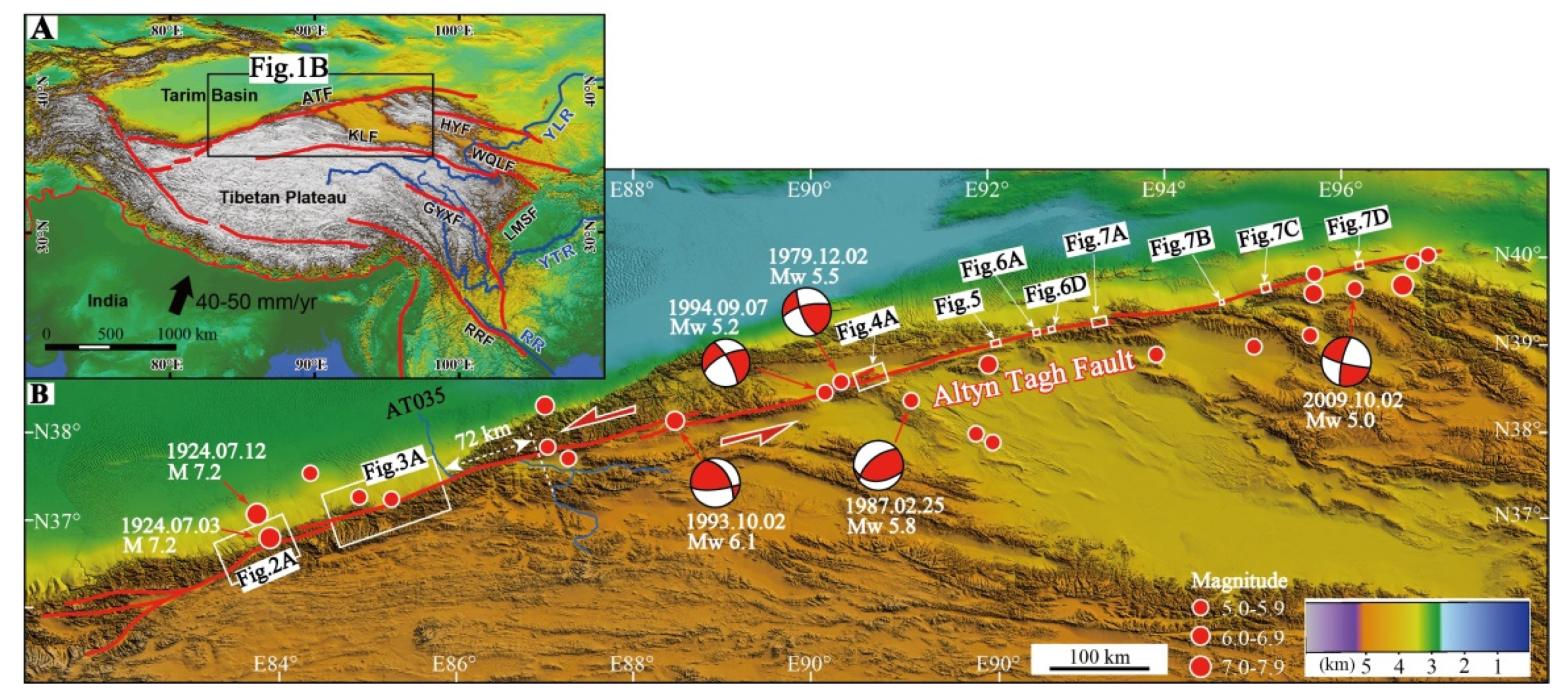
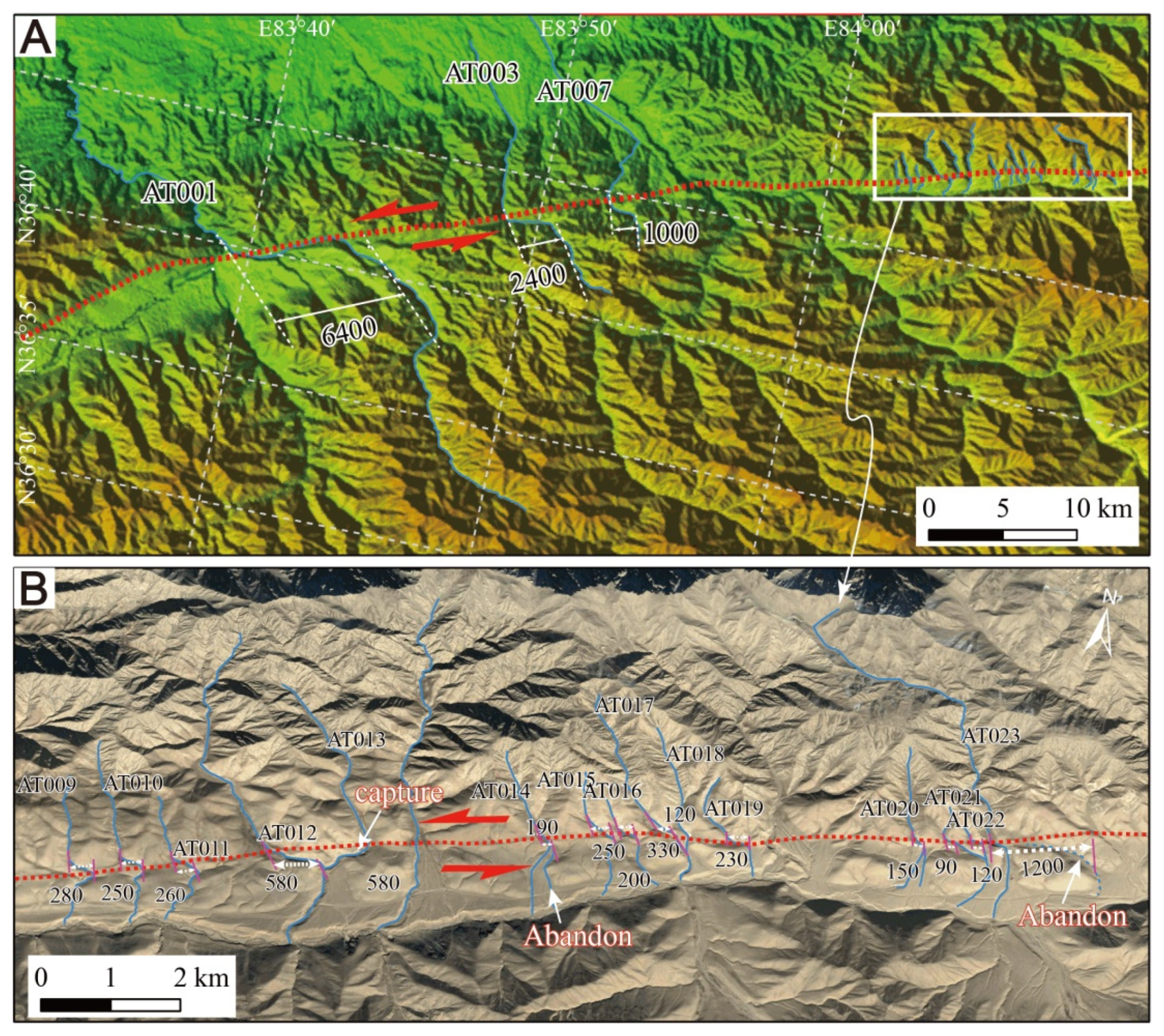

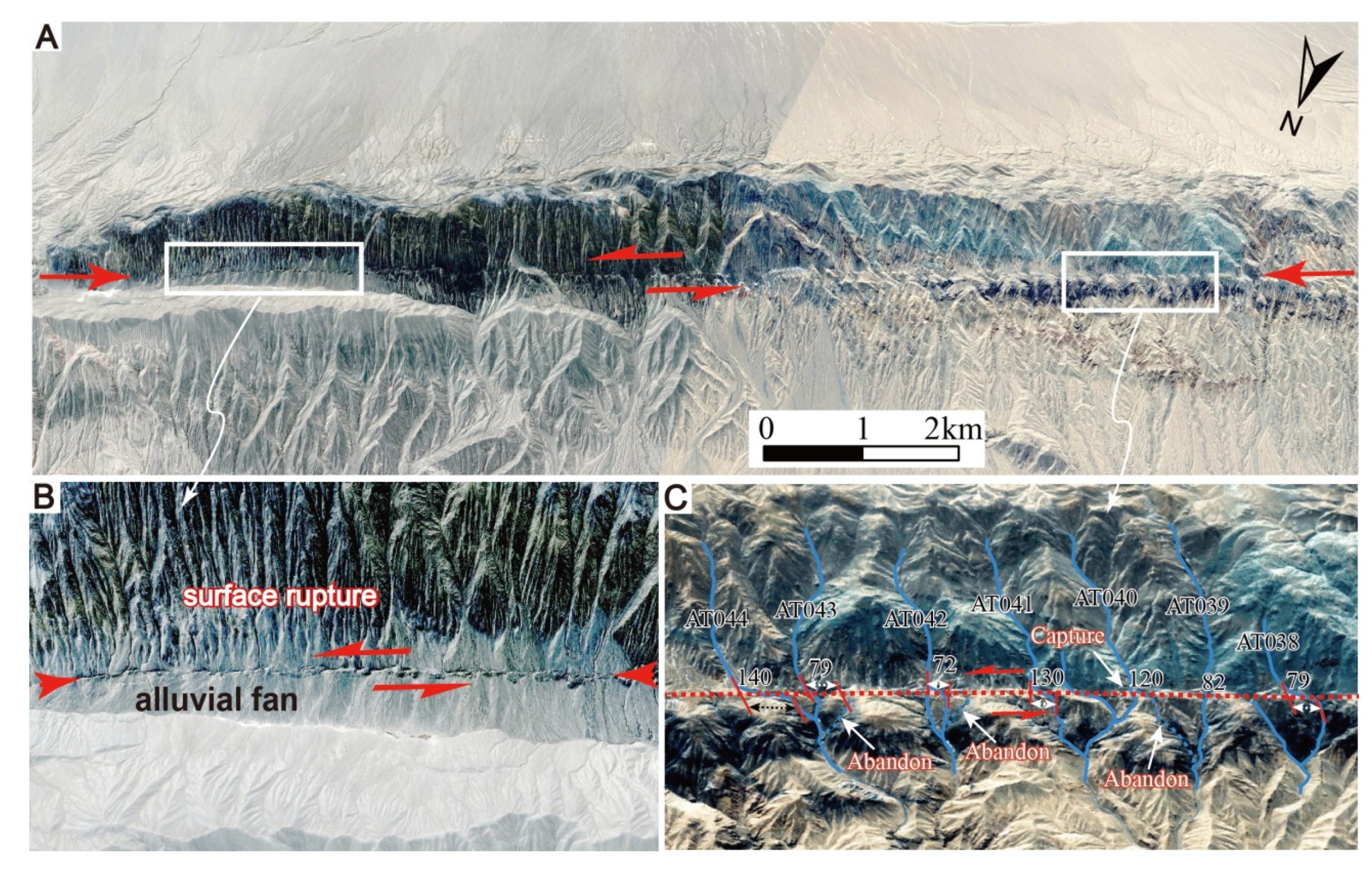
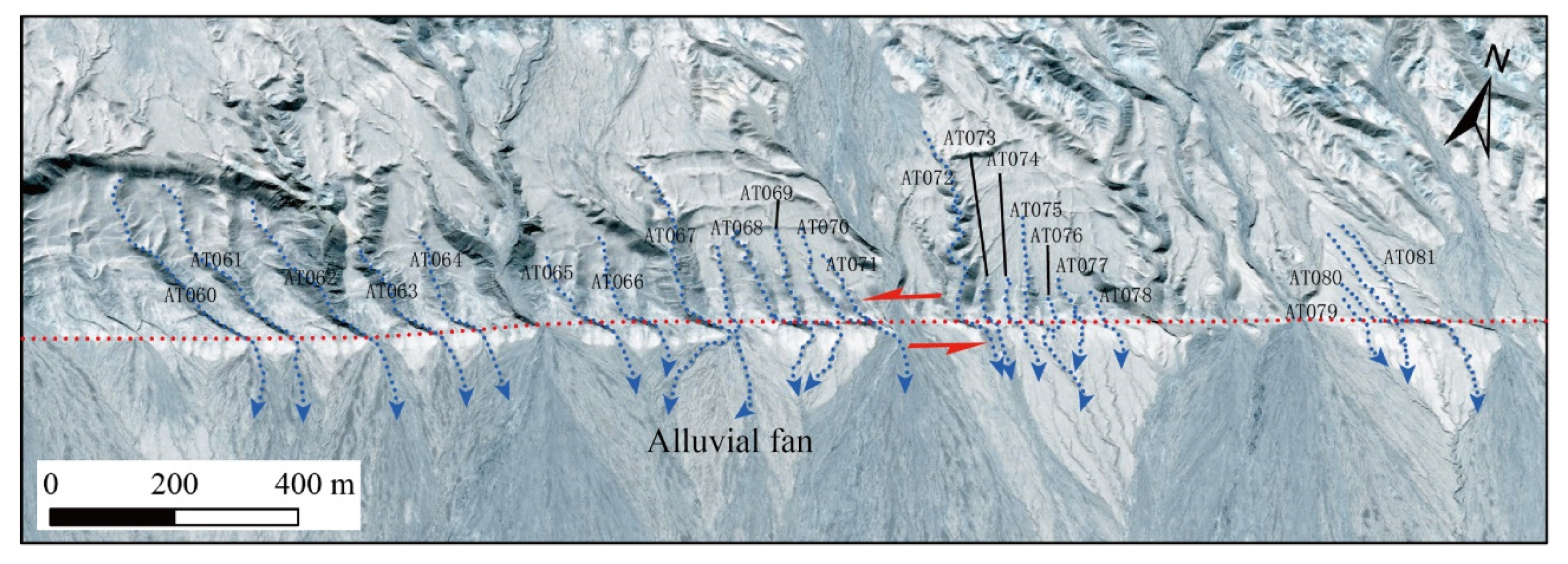


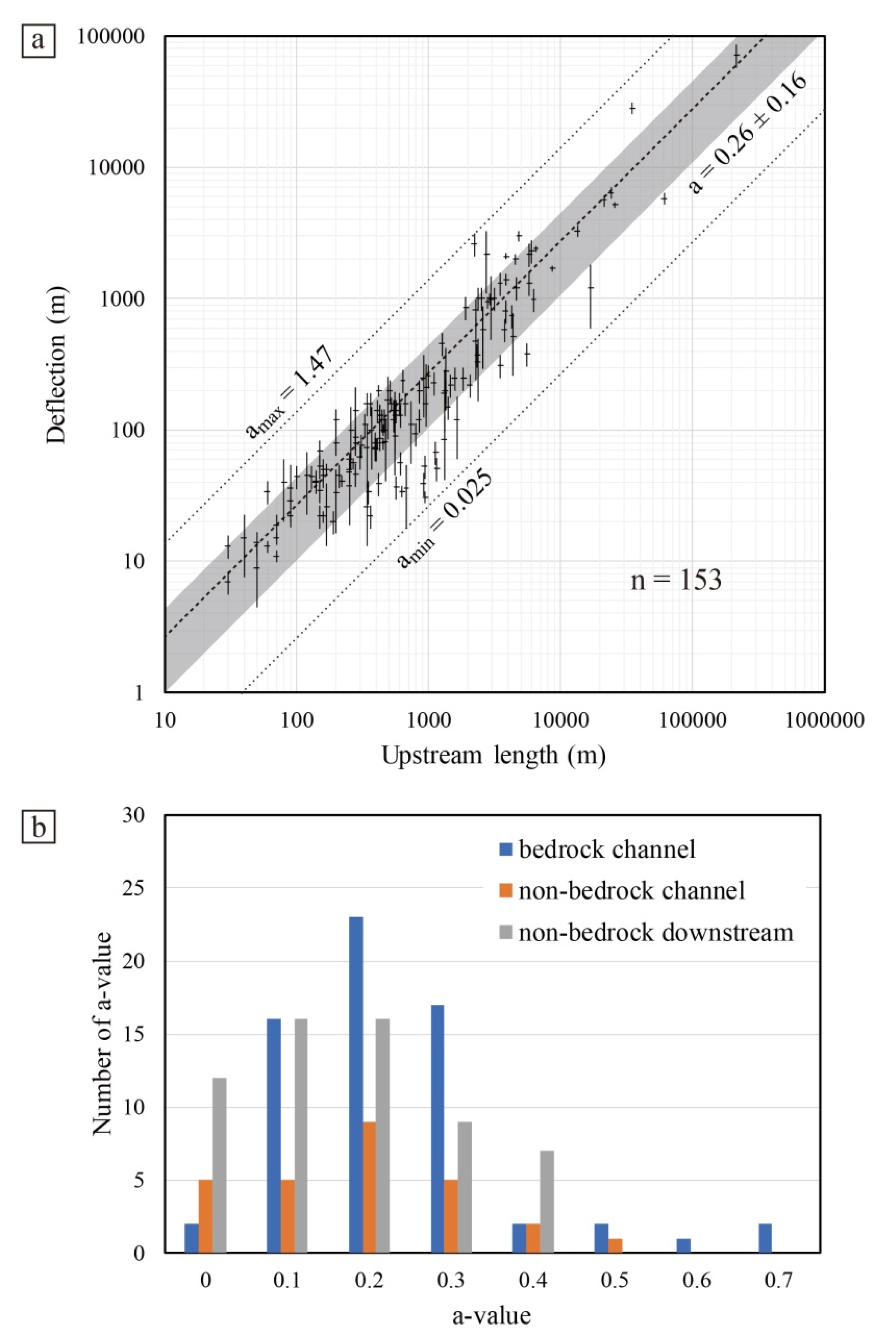
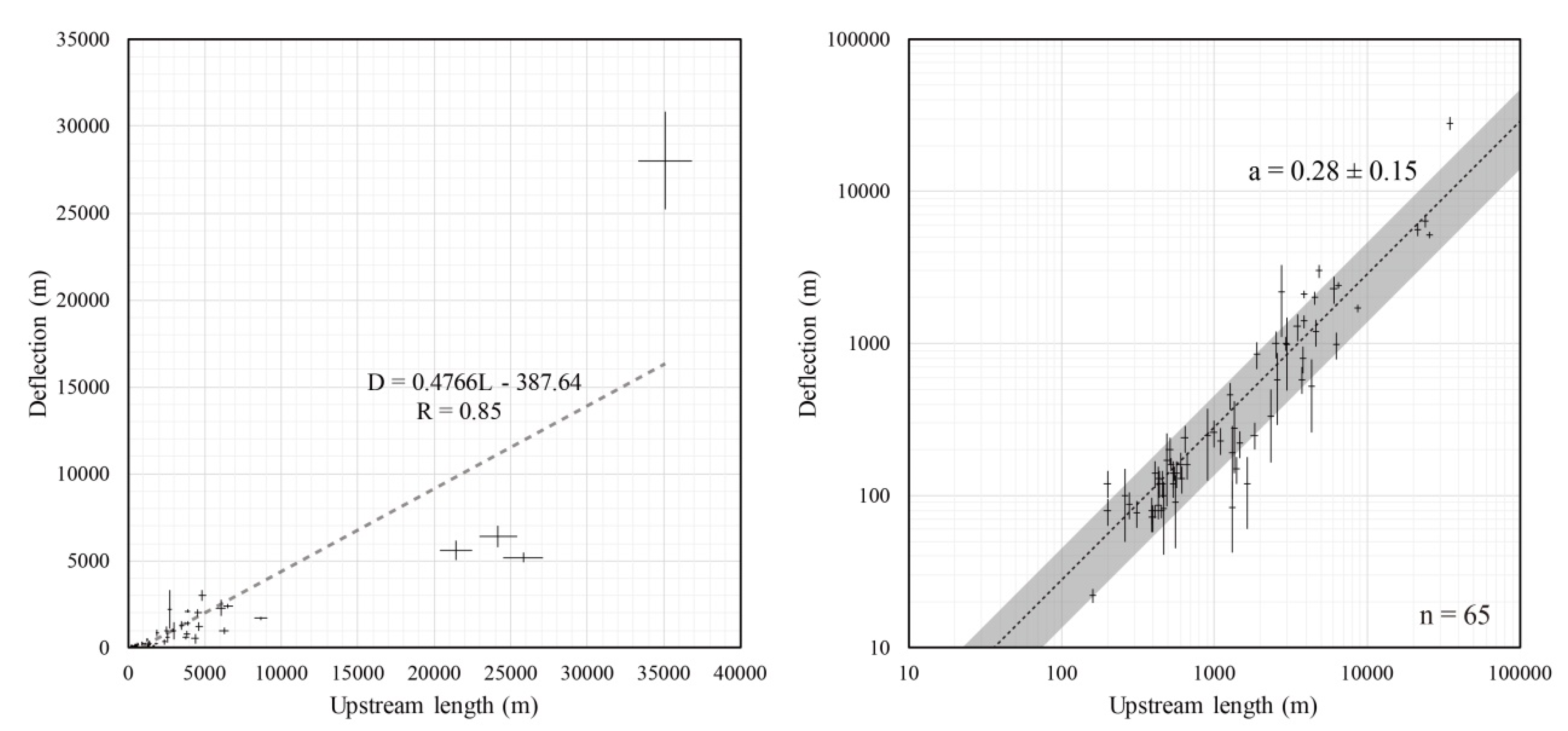
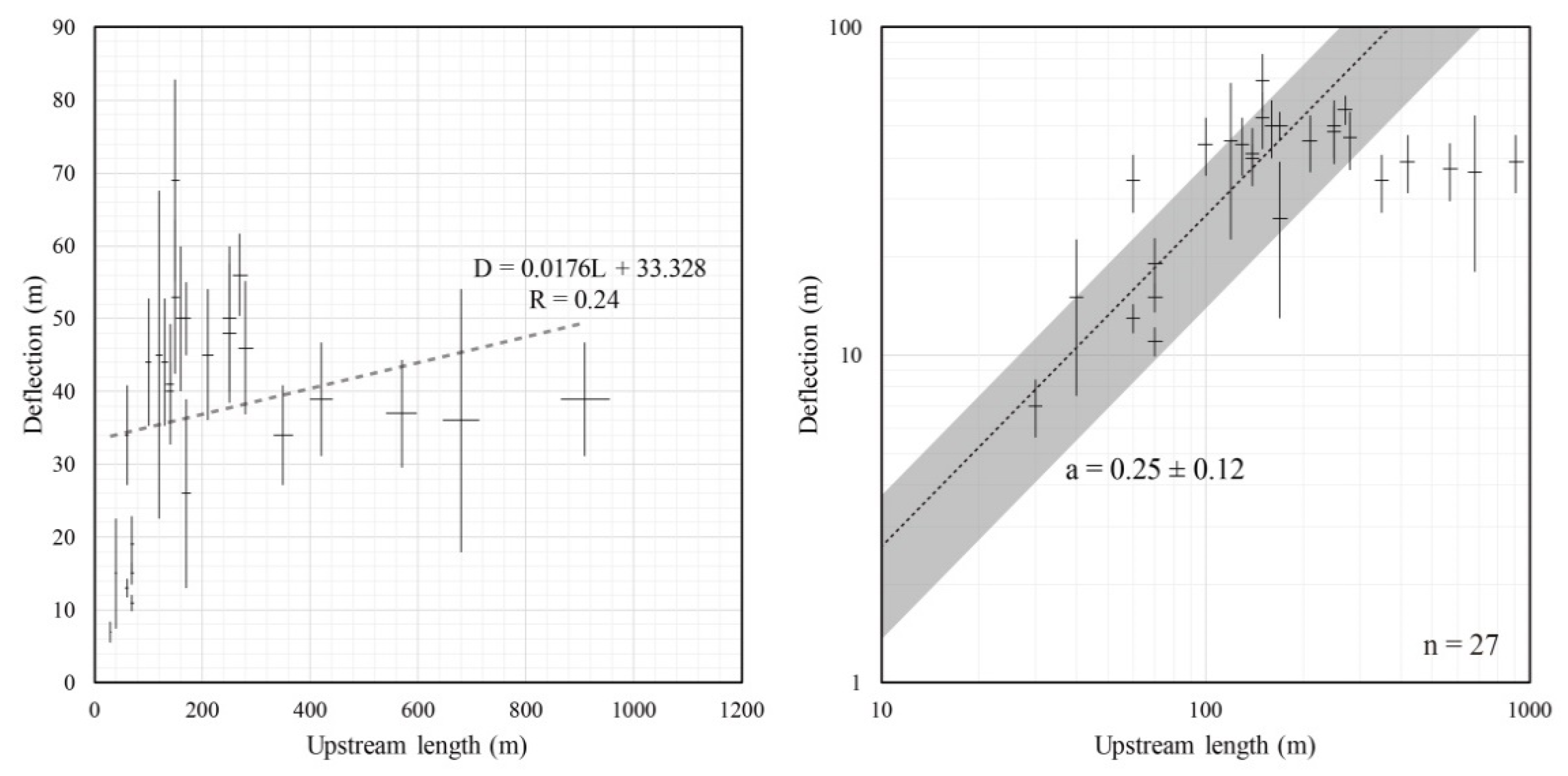
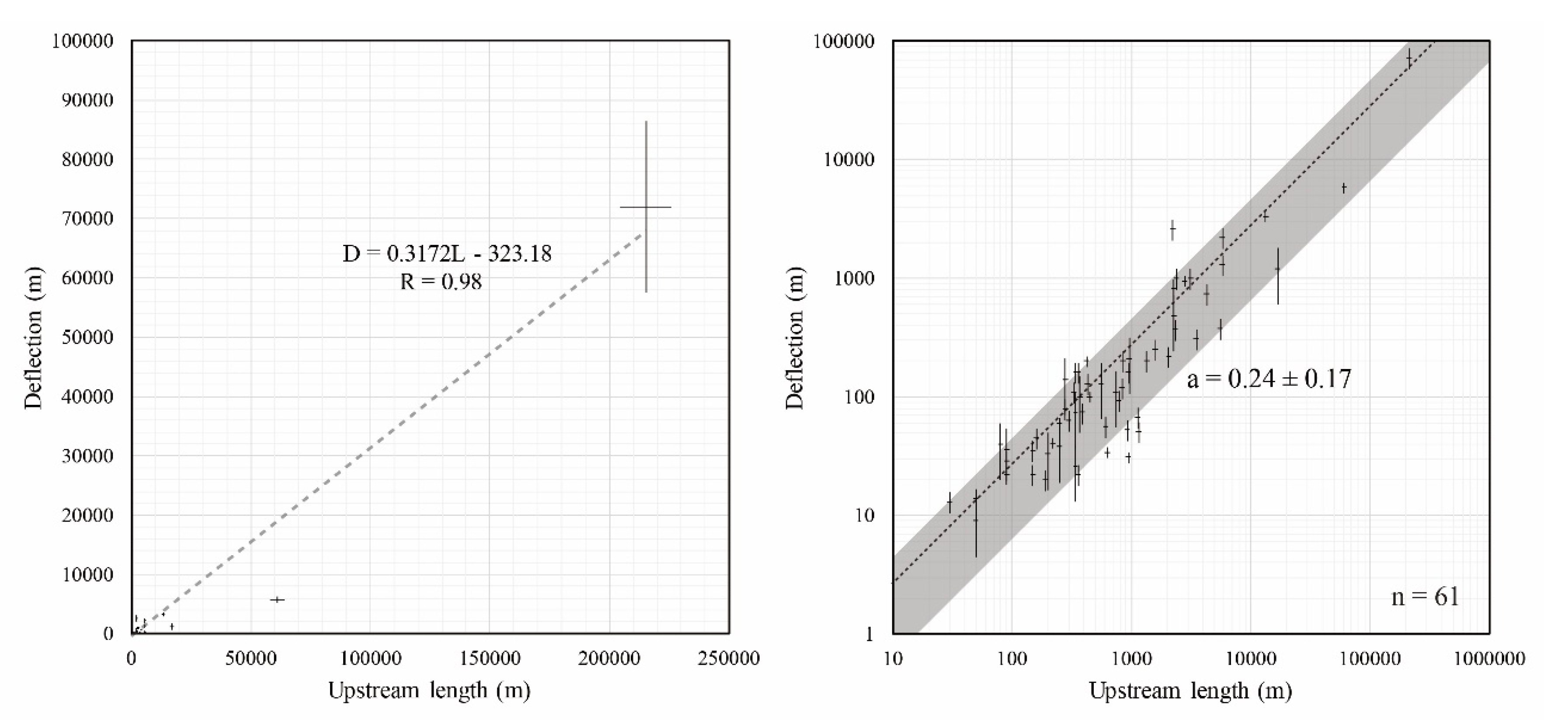
| Type | Timescale | Slip Rate (mm/yr) | Reference No. |
|---|---|---|---|
| Geologic rate | 49 Ma | 9 ± 2 | [23] |
| 24 Ma | 36 ± 9 | [24] | |
| 30 Ma | 7–9 | [30] | |
| late Oligocene | 12–16 | [31] | |
| 16.4 Ma | 10 | [32] | |
| ~5 Ma | 16–20 | [33] | |
| 16 Ma | 10 | [34] | |
| Late Quaternary rate | Holocene | 20–30 | [35] |
| Holocene | 17.5 ± 2 (western segment) 11 ± 3.5 (central segment) 4.8–2.2 (eastern segment) | [36] | |
| late Pleistocene | 20.3 ± 1.1 | [37] | |
| Holocene | 11.4 ± 2.5 | [38,39] | |
| Holocene | 8–17 | [40,41] | |
| Holocene | 4.7–6.7 | [42] | |
| Geodetic rate | 9 ± 5 | [43,44,45] | |
| 9 ± 2 | [46] | ||
| 8–9 | [47] | ||
| 9.0 ± 4 | [48] | ||
| 6.4 (91.5°E–95°E) | [50] | ||
| 8.1 ± 0.7 (~86°E) | [49] | ||
| 8.6 ± 1.5 (~90.4°E) | |||
| 4.5 ± 0.8 (94.6°E) | |||
| 11.9 ± 3.3 (89°E–91°E) | |||
| 4 (94°E–96°E) | [29] | ||
| 3.9 ± 2.3 (~96°E) |
| All Channels | Bedrock Channel | Non-Bedrock Channel | Non-Bedrock Downstream | |
|---|---|---|---|---|
| Number of Channels | 153 | 65 | 27 | 61 |
| Average a-value | 0.26 | 0.28 | 0.25 | 0.24 |
| Standard deviation (±σ) | 0.16 | 0.15 | 0.13 | 0.17 |
| Coefficient of Variance (%) | 60 | 52 | 53 | 73 |
| Correlation coefficient (L and D) | 0.95 | 0.85 | 0.24 | 0.98 |
Publisher’s Note: MDPI stays neutral with regard to jurisdictional claims in published maps and institutional affiliations. |
© 2021 by the authors. Licensee MDPI, Basel, Switzerland. This article is an open access article distributed under the terms and conditions of the Creative Commons Attribution (CC BY) license (https://creativecommons.org/licenses/by/4.0/).
Share and Cite
Chen, P.; Yan, B.; Liu, Y. Active Strike-Slip Faulting and Systematic Deflection of Drainage Systems along the Altyn Tagh Fault, Northern Tibetan Plateau. Remote Sens. 2021, 13, 3109. https://doi.org/10.3390/rs13163109
Chen P, Yan B, Liu Y. Active Strike-Slip Faulting and Systematic Deflection of Drainage Systems along the Altyn Tagh Fault, Northern Tibetan Plateau. Remote Sensing. 2021; 13(16):3109. https://doi.org/10.3390/rs13163109
Chicago/Turabian StyleChen, Peng, Bing Yan, and Yuan Liu. 2021. "Active Strike-Slip Faulting and Systematic Deflection of Drainage Systems along the Altyn Tagh Fault, Northern Tibetan Plateau" Remote Sensing 13, no. 16: 3109. https://doi.org/10.3390/rs13163109
APA StyleChen, P., Yan, B., & Liu, Y. (2021). Active Strike-Slip Faulting and Systematic Deflection of Drainage Systems along the Altyn Tagh Fault, Northern Tibetan Plateau. Remote Sensing, 13(16), 3109. https://doi.org/10.3390/rs13163109






